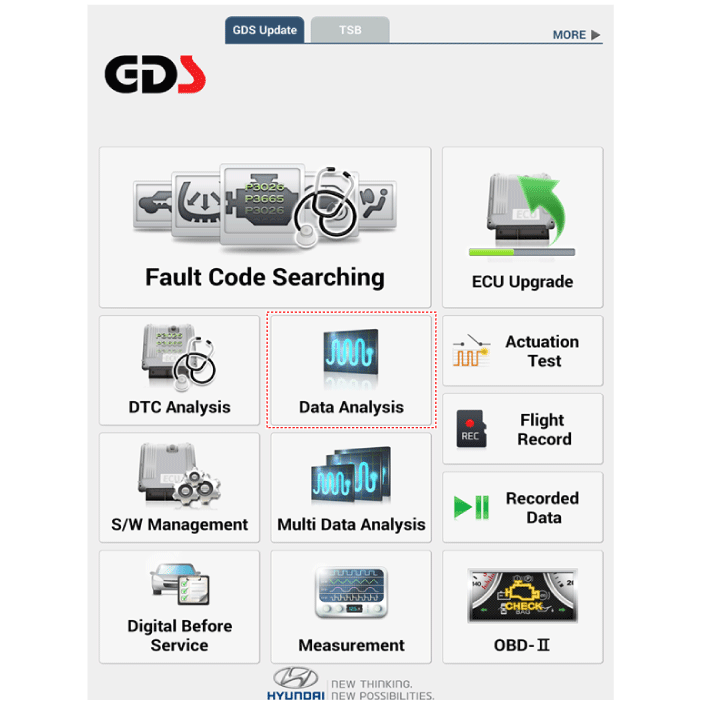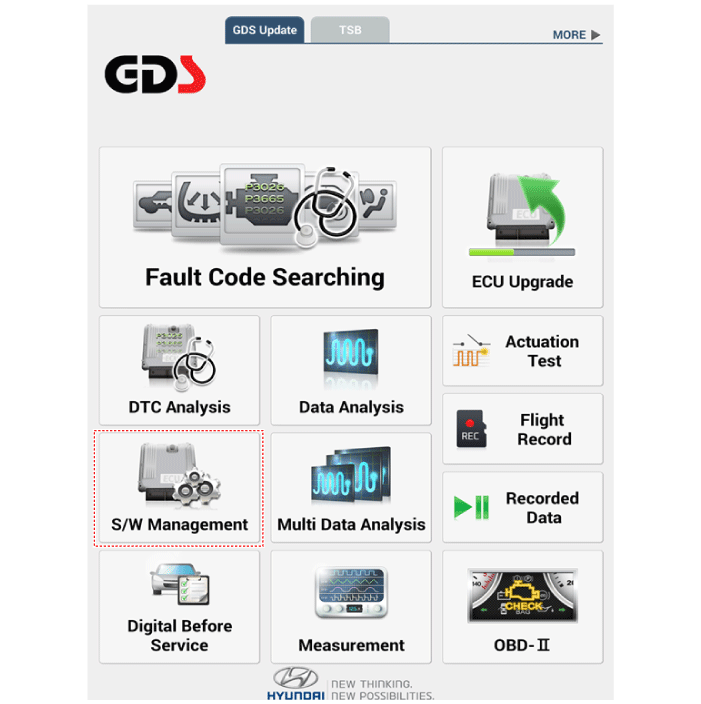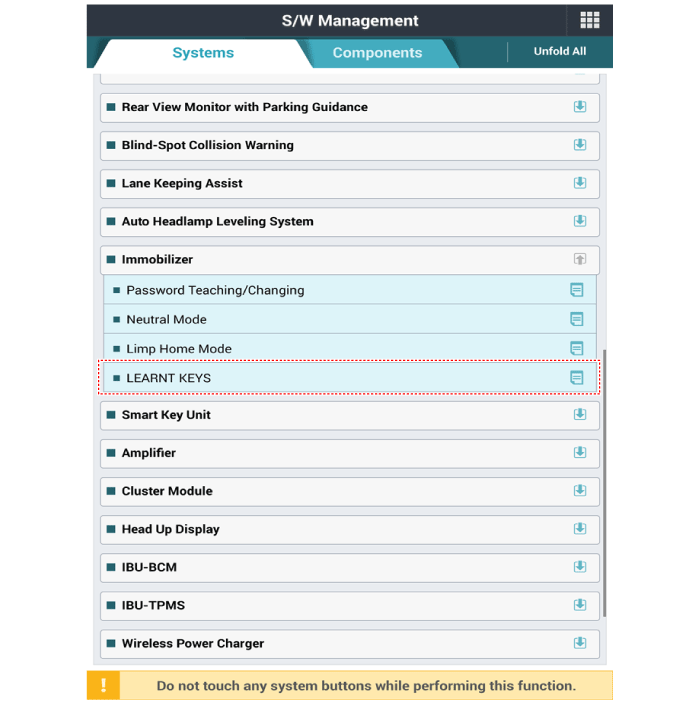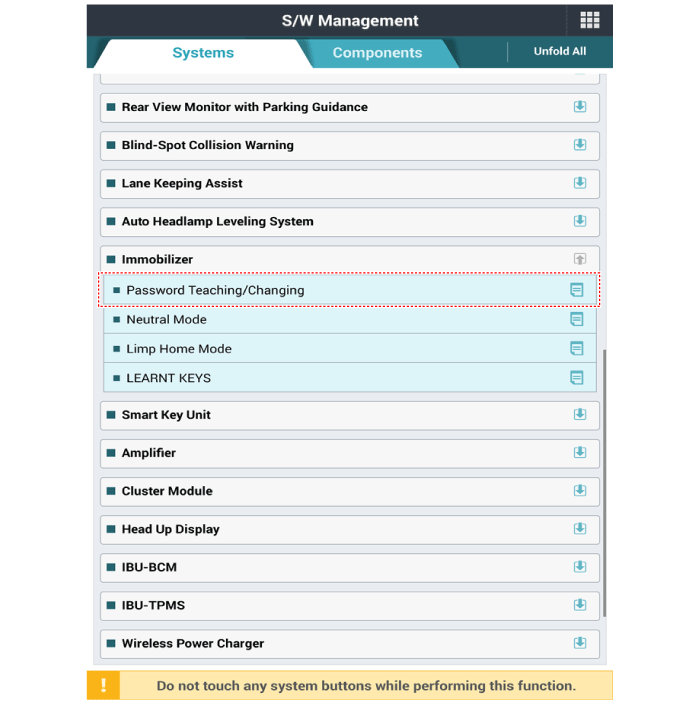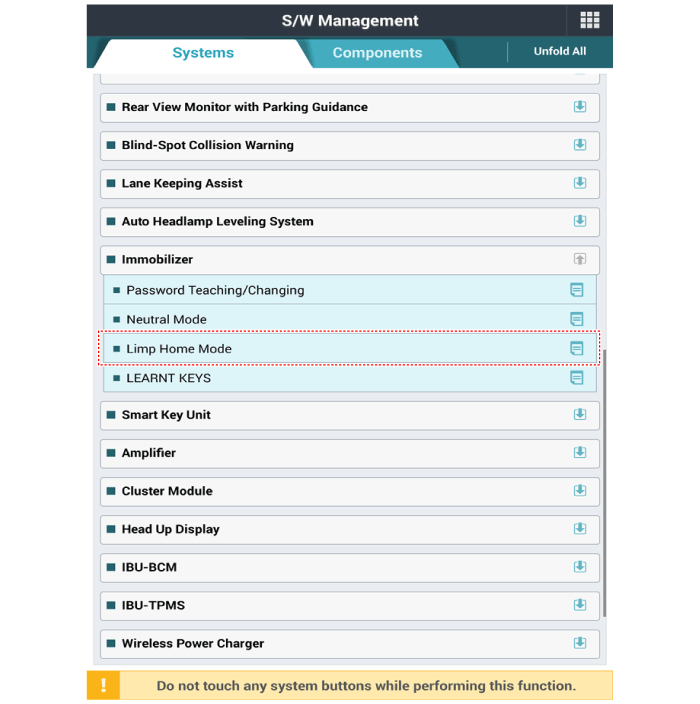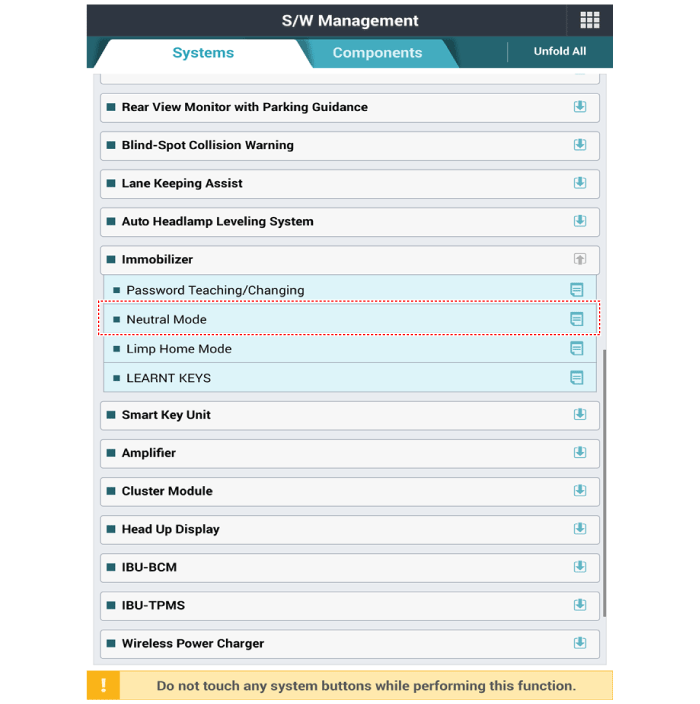Hyundai Santa Fe: Immobilizer System / Repair procedures
Hyundai Santa Fe (TM) 2019-2025 Service Manual / Body Electrical System / Immobilizer System / Repair procedures
| Diagnosis with diagnostic tool |
| 1. |
In the body electrical system, failure can be quickly diagnosed by using
the vehicle diagnostic system (diagnostic tool).
The diagnostic system (diagnostic tool) provides the following information.
|
Data Analysis
| 1. |
Select the 'Data Analysis' and 'Car model'.
|
| 2. |
Select the 'IMMO' to search the current state of the input/output data.
|
Key Teaching Procedure
Key teaching must be done after replacing a defective PCM(ECM) or when providing
additional keys to the vehicle owner.
The procedure starts with an PCM(ECM) request for vehicle specific data (PIN
code: 6digits) from the tester. The "virgin" PCM(ECM) stores the vehicle specific
data and the key teaching can be started. The "learnt" PCM(ECM) compares the
vehicle specific data from the tester with the stored data. If the data are
correct, the teaching can proceed.
If incorrect vehicle specific data have been sent to the PCM(ECM) three times,
the PCM(ECM) will reject the request of key teaching for one hour. This time
cannot be reduced by disconnecting the battery or any other manipulation. After
reconnecting the battery, the timer starts again for one hour.
The key teaching is done by ignition on with the key and additional tester commands.
The PCM(ECM) stores the relevant data in the EEPROM and in the transponder.
Then the PCM(ECM) runs the authentication required for confirmation of the teaching
process. The successful programming is then confirmed by a message to the tester.
If the key is already known to the PCM(ECM) from a previous teaching, the authentication
will be accepted and the EEPROM data are updated. There is no changed transponder
content (this is impossible for a learnt transponder).
The attempt to repeatedly teach a key, which has been taught already during
the same teaching cycle, is recognized by the PCM(ECM). This rejects the key
and a message is sent to the tester.
The PCM(ECM) rejects invalid keys, which are presented for teaching. A message
is sent to the tester. The key can be invalid due to faults in the transponder
or other reasons, which result from unsuccessful programming of data. If the
PCM(ECM) detects different authenticators of a transponder and an PCM(ECM),
the key is considered to be invalid.
The maximum number of taught keys is 4.
If an error occurs during the Immobilizer Service Menu, the PCM(ECM) status
remains unchanged and a specific fault code is stored.
If the PCM(ECM) status and the key status do not match for teaching of keys,
the tester procedure will be stopped and a specific fault code will be stored
at PCM(ECM).
|
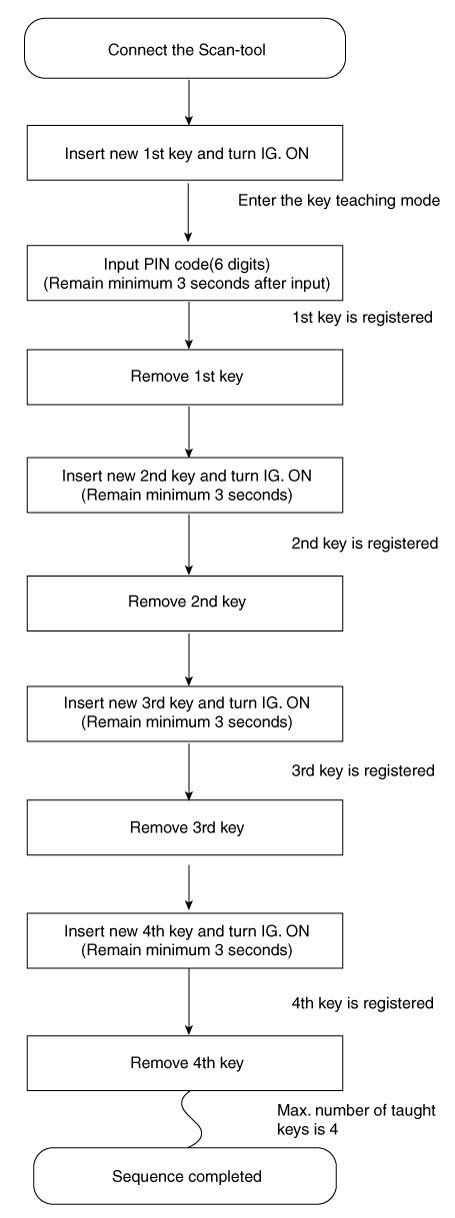
The following section describes how to diagnose faults using a diagnostic instrument.
| 1. |
Connect the cable of diagnostic tool to the data link connector in driver
side crash pad lower panel, and turn on the diagnostic tool.
|
| 2. |
Select the 'S/W Management' and 'Car model'.
|
| 3. |
Select "Imoobilizer" and "LEARNT KEYS".
|
| 4. |
Perform the "LEARNT KEYS" procedure according to the diagnostic tool
screen message.
|
Password Teaching / Changing
The user password for limp home is taught at the service station. The owner
of the vehicle can select a number with four digits.
The user password teaching is only accepted by a "learnt" PCM(ECM). Before first
teaching of user password to an PCM(ECM), the status of the password is "virgin"
No limp home function is possible.
The teaching is started by ignition on, with a valid key(learnt key) and sending
the user password by tester. After successful teaching, the status of the user
password changes from "virgin" to "learnt".
The learnt user password can also be changed. This can be done if the user password
status is "learnt" and the tester sends authorization of access, either the
old user password or the vehicle specific data. After correct authorization,
the PCM(ECM) requests the new user password. The status remains "learnt" and
the new user password will be valid for the next limp home mode.
If wrong user passwords or wrong vehicle specific data have been sent to the
PCM(ECM) three times continuously or intermittently, the PCM(ECM) will reject
the request to change the password for one hour. This time cannot be reduced
by disconnecting the battery or any other actions. After reconnecting the battery,
the timer starts again for one hour.
The following section describes how to diagnose faults using a diagnostic instrument.
| 1. |
Connect the cable of diagnostic tool to the data link connector in driver
side crash pad lower panel, and turn on the diagnostic tool.
|
| 2. |
Select the 'S/W Management' and 'Car model'.
|
| 3. |
Select "Imoobilizer" and "Password Teaching / Changing".
|
| 4. |
Perform the "Password Teaching / Changing" procedure according to the
diagnostic tool screen message.
|
Limp Home Function
If the PCM(ECM) detects the fault of the SMARTRA or transponder, the PCM(ECM)
will allow limp home function of the immobilizer. Limp home is only possible
if the user password (4 digits) has been given to the PCM(ECM) before. This
password can be selected by the vehicle owner and is programmed at the service
station.
The user password can be sent to the PCM(ECM) via the special tester menu.
Only if the PCM(ECM) is in status "learnt" and the user password status is "learnt"
and the user password is correct, the PCM(ECM) will be unlocked for a period
of time (30 sec.). The engine can only be started during this time. After the
time has elapsed, engine start is not possible.
If the wrong user password is sent, the PCM(ECM) will reject the request of
limp home for one hour. Disconnecting the battery or any other action cannot
reduce this time. After connecting the battery to the PCM(ECM), the timer starts
again for one hour.
| 1. |
Connect the cable of diagnostic tool to the data link connector in driver
side crash pad lower panel, and turn on the diagnostic tool.
|
| 2. |
Select the 'S/W Management' and 'Car model'.
|
| 3. |
Select "Imoobilizer" and "Limp Home Mode".
|
| 4. |
Perform the "Limp Home Mode" procedure according to the diagnostic tool
screen message.
|
Neutralizing Of ECM
The PCM(ECM) can be set to the "neutral" status by a tester.
A valid ignition key is inserted and after ignition on is recorded, the PCM(ECM)
requests the vehicle specific data from the tester. The communication messages
are described at "Neutral Mode" After successfully receiving the data, the PCM(ECM)
is neutralized.
The ECM remains locked. Neither the limp home mode nor the "twice ignition on"
function, is accepted by the PCM(ECM).
The teaching of keys follows the procedure described for the virgin PCM(ECM).
The vehicle specific data have to be unchanged due to the unique programming
of the transponder. If data should be changed, new keys with a virgin transponder
are requested.
This function is for neutralizing the PCM(ECM) and Key. Ex) when lost key, Neutralize
the PCM(ECM) then teach keys.
(Refer to the Things to do when Key & PIN Code the PCM(ECM) can be set to the
"neutral" status by a scanner. If wrong vehicle specific data have been sent
to SMATRA three times continuously or intermittently, the SMATRA will reject
the request to enter neutral mode for one hour. Disconnecting the battery or
other manipulation cannot reduce this time. After connecting the battery the
timer starts again for one hour.
|
| 1. |
Connect the cable of diagnostic tool to the data link connector in driver
side crash pad lower panel, and turn on the diagnostic tool.
|
| 2. |
Select the 'S/W Management' and 'Car model'.
|
| 3. |
Select "Imoobilizer" and "Limp Home Mode".
|
| 4. |
Perform the "Limp Home Mode" procedure according to the diagnostic tool
screen message.
|
 Description and operation
Description and operation
Description
The immobilizer system will disable the vehicle unless the proper ignition key
is used, in addition to the currently available anti-theft systems such as car
alarms, the immobilizer system aims to drastically reduce the rate of auto theft...
 Immobilizer Control Unit. Repair procedures
Immobilizer Control Unit. Repair procedures
Removal
1.
Disconnect the negative (-) battery terminal.
2.
Remove the glove box housing...
Other information:
Hyundai Santa Fe (TM) 2019-2025 Owner's Manual: Side curtain
To use the side curtain: 1. Lift the curtain by the hook (1). 2. Hang the curtain on both sides of the hook. CAUTION Always hang both sides of the curtain on the hook. This could cause damage to the side curtain if only one side of the curtain is hooked...
Hyundai Santa Fe (TM) 2019-2025 Service Manual: Repair procedures
Inspection Front Door Lock Module Inspection 1. Remove the front door trim. (Refer to Body - "Front Door Trim") 2. Remove the front door module. (Refer to Body - "Front Door Module") 3...
Categories
- Manuals Home
- 4th Generation Santa Fe Owners Manual
- 4th Generation Santa Fe Service Manual
- Power adjustment
- Electronic child safety lock
- Seat cushion extension adjustment (for driver's seat)
- New on site
- Most important about car
Power adjustment
The front seat can be adjusted by using the control switches located on the outside of the seat cushion. Before driving, adjust the seat to the proper position so that you can easily control the steering wheel, foot pedals and controls on the instrument panel.
WARNING
NEVER allow children in the vehicle unattended. The power seats are operable when the vehicle is turned off.
Copyright © 2025 www.hsafe4.com

